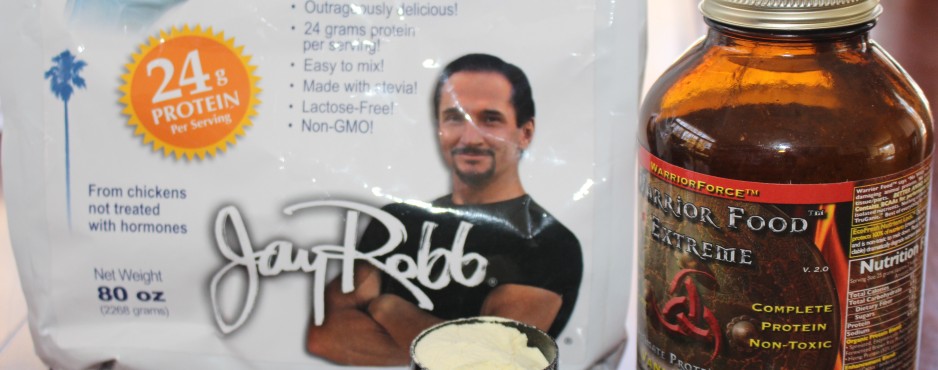I can’t go to the gym with out seeing people carrying around protein drinks, all different colors and sizes. Is there a Jamba Juice on every corner in NYC or is just me? (by the way Jamba juice uses mostly soy products which can be ok in small doses but can pose problems if consumed in high amounts) their whey protein boost does not reveal the type or source in the ingredient listing and most of their 16 oz smoothies contain in excess of 40 grams of sugar! Their “super green” 28 oz smoothies contains 97 grams of sugar! yikes)
So really what is the scoop? What are we really drinking when we gulp down smoothies, are they good for us? Do we really need them?
How is Protein powder made?
Whey protein is derived from milk during the making of cheese through a natural fermentation process. Cow’s milk contains two types of protein, a large part that consists of casein protein and another small part that consists of whey protein. When cheese is created, the casein is the part of the milk that makes up the cheese, and the whey protein is the liquid that is left over after you separate out all the milk solids.
Sometimes there is liquid on top of natural yogurts when you open them at home. That is whey protein in it’s original form. The liquid whey then goes through a drying process to remove all the water to turn it into powder.
Hemp, Rice, Pea, and Soy protein powders are all non-dairy forms of protein, made by drying the seed, nut or grain and grinding into powder. Last but not least is Egg White Protein powder, this is made by separating the yolk and the whites and dehydrating the white part.
As whey is the most widely used and tested powder and is a complete protein, my research is based on this type.
Protein powder terms:
A complete protein contains all 9 essential amino acids that the body cannot make. Whey, hemp, soy and egg white are all complete proteins. A concentrated protein means that the powder left is 70-85% protein with some carbohydrate and fat left over. An isolate protein means it is reduced down even further and usually contains 95% pure protein.
Ion exchanged, Cross Flow Micro filtration (CFM) ultra filtration (UF), micro filtration (MF), reverse osmosis (RO), dynamic membrane filtration (DMF), ion exchange chromatography, (IEC), electro-ultrafiltration (EU), radial flow chromatography (RFC) nano filtration (NF) and hydrolyzed are all ways to filter the whey protein and concentrate it. Cross Flow Micro filtration is the least denatured of these (meaning the least amount of change occurs to the structure of the primary protein) and is usually cold pressed so the native protein structures remain intact to a large degree. More of the beneficial micro fractions (things such as immunoglobulins that help immune and appetite function), exist in higher concentrations when this method is used.
So what’s the scoop?
Our bodies need protein, it is the building block of every living cell. It doesn’t just build muscle it builds hair, skin, nails, tendons, ligaments, blood plasma, organ tissue and almost 2000 enzymes! There are many different opinions on how much protein we need ranging from the low RDA recommendation of 46 grams/day for women and 56 grams a day for men to 1-1.5 gram per pound of body weight! The range I believe is most appropriate for a typical moderately active person (based on opinion after reading much data) is about 15% of our daily intake of food. So for an average man that would be 113 grams for a 3000 calorie a day diet or 83 grams for a women on a 2200/day diet. Studies show that eating high protein does not cause kidney disease, but once you have kidney disease, eating lower amounts of protein may help. If you have an existing kidney disease please consult with your Doctor.
Are their people who can benefit from eating 20% or more protein per day? Possibly.
If your trying to lose weight (protein is more filling than carbs or fat) increase muscle mass, have blood sugar problems, train hard, are over 65, or have high stress you may benefit.
I’d say eating whole foods for protein is your best bet. But even though we can meet all our dietary protein needs from a hunk of meat, chicken or an egg most people don’t eat enough of these to stay full and obtain the benefits they can offer, supplementation is to help us do more that just fill a requirement it is also for convenience and to help us do better! So what are the best protein powders to use?
First lets list what to avoid.
What to avoid: added MSG (on a side note protein powders contain free glutamate which is a naturally occurring form of MSG as when it’s processed the amino acids become unattached turning them from a bonded to a free glutamate, if you are MSG sensitive I would not consume protein powder, if you have unexplained headaches try cutting out all MSG and foods containing free Glutamates), artificial flavors, partially-hydroganated oils, artificial colors, artificial sweeteners including (Acesulfame-K, aspartame, Sucralose)
Are protein powders denatured?
Denaturing is any change in the primary, secondary, or tertiary structure of the source material, that takes it away from it’s natural state. Generally denatured proteins function differently than unaltered ones but different is not always bad! I love this article here that explains this in detail.
The amino acid sequences do not change when protein is denatured, and whether a protein is denatured during processing or in your body does not affect its muscle-building, fat burning qualities. All large proteins are broken down during digestion into smaller protein chains and individual amino acids (denatured), and whether this process occurs in the gut or in the manufacturing plant is irrelevant to the muscle fibers getting these proteins. Pasteurizing milk will denature it, even at the lowest temperature allowed by the FDA because it will cause changes in certain fractions. All whey protein is made from pasteurized dairy, it’s the law! Not every whey protein powder is denatured to the same extent, but it’s all denatured. But does this really matter? Probably not. The majority of Whey Protein studies in athletes have been done on denatured whey protein. Those studies almost universally show that whey protein enhances performance, and also helps you build muscle and burn fat, not to mention having a ton of other beneficial properties. Non-denatured whey protein is non-existent. It’s a marketing gimmick!
Should I use concentrate or isolate?
Pushing the liquid portion of milk through a filter creates whey protein. The material left behind is dried and forms whey protein concentrate. Concentrate contains varying amounts of fat and carbohydrates in the form of lactose. The percentage of protein varies from about 30% to about 80%.
Whey concentrate is further processed and purified into whey protein isolate, containing about 95% protein.
When choosing a whey protein product, it is important to consider your goals, budget, and any allergies. For example, since whey concentrates contain significant amounts of lactose, anyone with lactose intolerance should avoid them. Isolates contain a higher amount of protein per serving. For people who are calorie restricting and trying to consume as much real food as possible the higher the protein content the lower the carbohydrate and fat which leaves more room for whole foods. Whey isolates are more rapidly absorbed than concentrates and create a more profound insulin response. This makes whey isolates popular post-workout choice.
Concentrate contains trace amounts of lactose and milk fat, it might be considered more of a whole food but when using whey, most people are trying to obtain a very specific nutrient – protein. Add your fat and other nutrients into your diet another way. Concentrate is not necessary in my opinion and more reactive to people that don’t digest dairy well.
The vast majority of studies examining whey protein’s beneficial effects on general health, immune functioning, and recovery from training use whey protein isolate, not whey protein concentrate.
Proven Benefits:
Among patients with fatty liver, whey protein isolate supplementation improves liver blood work and reduced fatty deposition. It also increases glutathione production (which is the body’s most effective immune builder and antioxidant) and these increases correlate with the improvements in liver health.
A combination of whey protein isolate and resistance training boost glutathione levels, HDL, and total antioxidant capacity.
In both young and older men, whey isolate after resistance training increases muscle protein synthesis (but older men need more protein to get the same effect).
Whey is among the richest source of BCAA’s or branched chain amino acids such as lucine. Beta-Lactoglobulin in whey increases the absorption of fat soluble vitamins and prevents the breakdown of muscle tissue. After 20 we start to lose muscle mass. This leads to insulin resistance which can lead to the middle age belly.
Whey helps spare glycogen stores (energy in your muscles and liver) during exercise.
Whey is rich in Alpha-lactalbumin which provides an anabolic environment for strength and muscle growth, it is natures highest source of an often missing amino acid called tryptophan. Tryptophan helps with the production of the brain chemical serotonin.
Whey contains Lactoferrin which inhibits bacteria from attaching to the gut wall. and can help with overall gut health.
Whey protein powder has been associated with reduced total body mass and waist circumference
I’ve seen people pushing concentrate because it contains conjugated linoleum acid (CLA) this is a dairy fatty acid with some beneficial health effects. This may be true but the amount of CLA in full fat dairy is quite small to begin with. Once it is reduced down to the concentrate the amount of fat left is negligible. Take as a separate supplement if you want the benefits of CLA.
Whey isolate is the superior product overall. It’s far higher in protein than concentrate, ranging from 90% protein and up.
What about grass-fed whey?
Why do we eat grass-fed meat and milk? Grass-feeding can affect the fatty acid, antioxidant, and micronutrient content of meat and dairy in a favorable way, but not the amino acid profile. Whey protein is about the protein. The amino acid profile of grass-fed whey protein is identical to that of grain-fed whey protein. If you were going with a high-fat whey concentrate, you might want grass-fed, but once again the amount of fat in most whey concentrates is so low as to make the fatty acid profile irrelevant.
Bottom Line:
We need protein! If you are not an overly active person, have time to cook and access to whole food options, protein powder may not be necessary for you.
Whey protein has been shown to augment muscle protein synthesis, support fat burning, boost the immune system, improve insulin sensitivity, and decrease appetite.
If you a like the convenience of protein powders, work out a lot, are trying to loose weight or need additional protein in your diet, feel free to have a daily protein shake, but choose wisely!!
Review the ingredients before buying any product, do not let the sales person at GNC talk you into a big tub of crap because it is on sale. If you are putting this stuff into your body everyday it needs to be a good product! Look for cold-pressed, cross micro-filtered whey protein isolate without artificial sweeteners.
If you are a person that suffers from headaches often and cannot pinpoint the reason, try removing glutamate from your diet to see if it helps. Free glutamate is present in protein powder, it is not added msg it is naturally occurring but could effect you if you react to msg.
I do not feel the nutrition left in whey concentrate is enough or has had enough studies done on it to recommend it over isolate. I also do not believe there has been enough studies done on hydrolyzed protein powders (which are usually more expensive), to recommend those either.
On a personal note I have used Jay Robb protein powder for as long as I can remember and am very happy with it. It is sold at Wholefoods or Amazon. It is cold-processed, cross-flow micro filtered whey protein isolate and is sweetened with stevia.


